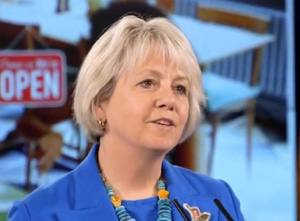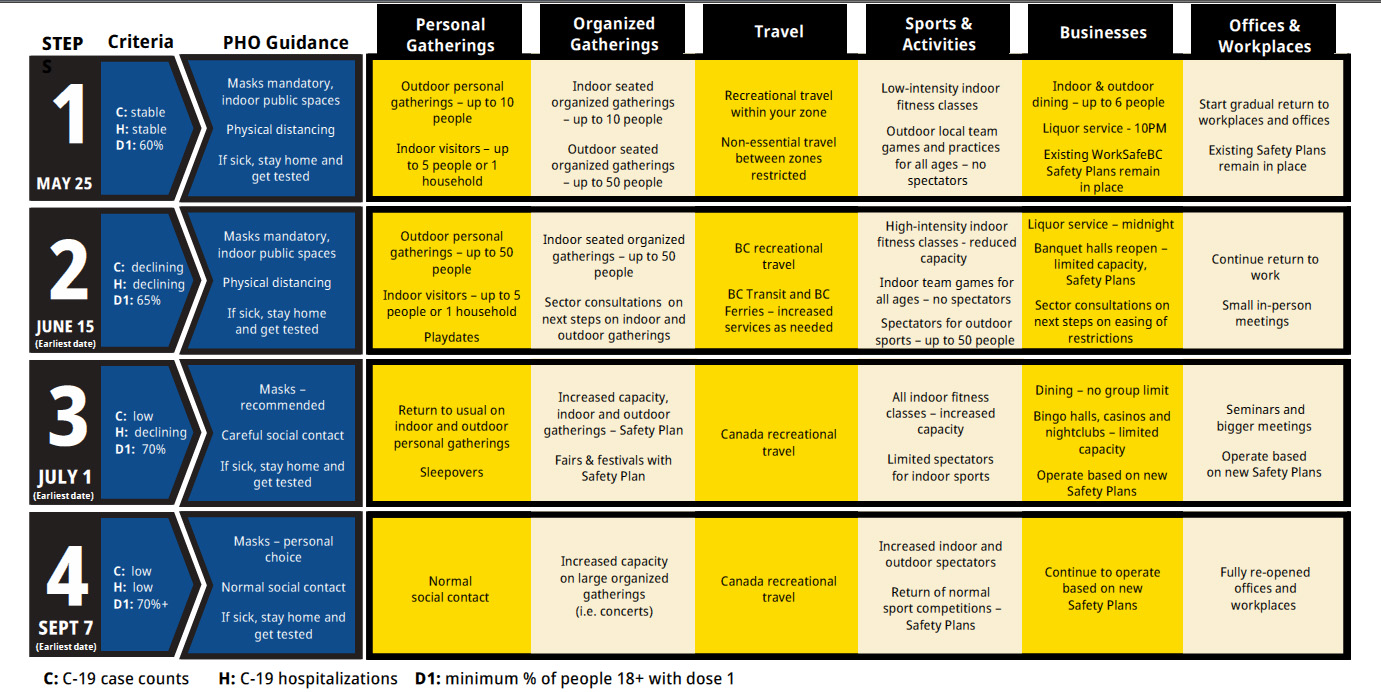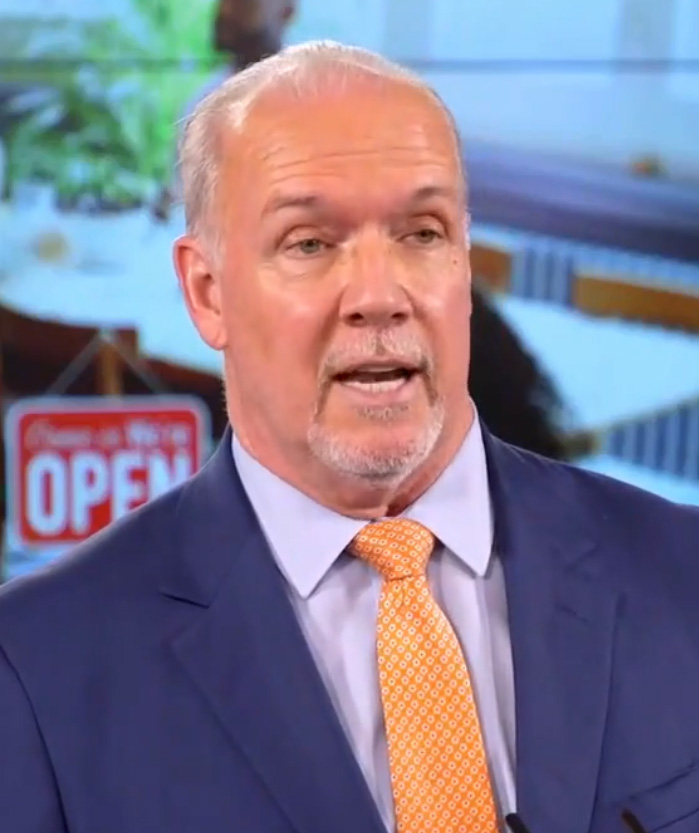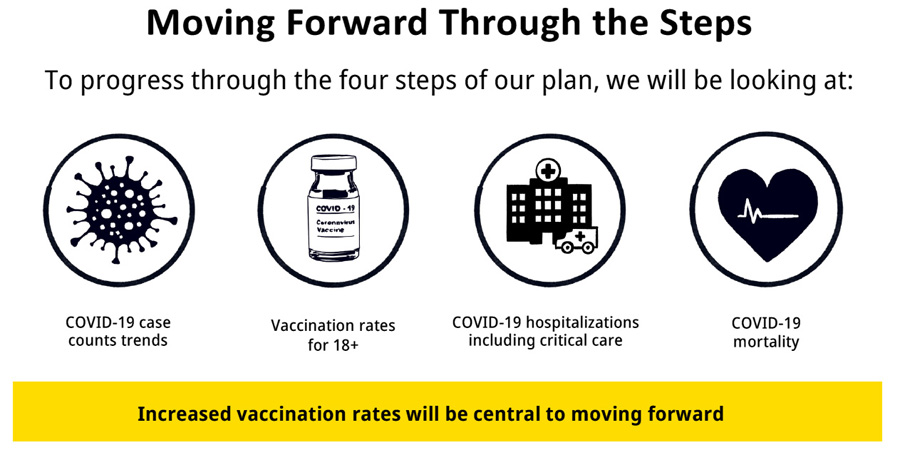
Tuesday May 25, 2021 | VICTORIA, BC [Posted at 1 pm, updated at 4 pm & 6:10 pm]
by Mary P Brooke, B.Sc., Editor | Island Social Trends
We’re past the May Long Weekend in BC, and a new phase of living with COVID has begun.
With now more than 60% of adults vaccinated with a first dose of COVID-19 vaccine, and COVID-19 case counts and hospitalizations steadily declining, BC officials says the province is moving forward with the cautious first step of a four-step plan for what it calls a “careful and safe restart”.
Calling it a “slow and gradual return to a more normal life”, the plan includes safety and health protocols such as mask wearing and physical distancing remaining in place (in fact as mandatory during the initial two steps of the plan).
The announcement about the new 4-step restart plan was led today by Premier John Horgan, along with Minister of Jobs, Economic Recovery and Innovation Ravi Kahlon, together with Health Minister Adrian Dix and Provincial Health Officer Dr Bonnie Henry.

This morning, professional media got a one-hour tech briefing, followed by the 1 pm public livestreamed media teleconference.
Genuine excitement, though pandemic continues:
Today Dr Henry said that “as cases continue to decline and immunizations steadily rise, we are moving forward with purpose, monitoring our progress to ensure we remain on track”. She was genuinely pleased with BC being at this phase in the pandemic where reopening society and easing back on restrictions is truly possible.
Though at the same time, the Province extended the Provincial State of Emergency to June 8, 2021, which underscores that we are still in a pandemic.
In most ways, nothing much has changed. Progressing through the steps will be measured by the number of adults vaccinated, COVID-19 case counts, and hospitalizations and deaths.
Dr Henry did acknowledge that individuals, households and communities will want to emerge to greater levels of contact as they feel comfortable doing so. That will include whether or not to wear masks around known groups of people, when to start having group meetings again in business, and whether or how far to travel.
Data not dates:
Clusters and outbreaks will be taken into account. While there are approximate dates, the plan will be guided by data, not dates, and will not proceed to the next step until it is safe to do so based on guidance from public health and the latest available data.
It should be noted that the data on immunizations is about the percentage of adults (age 18+) who have received a first dose. That leaves a lot of flexibility around the uptake of that apparently all-important second dose and also how many children and youth have been immunized.

Evidently more second-dose timeline rollout is coming on Thursday (May 28) in Dr Henry’s next COVID briefing. She has said several times already, however, that the interval between first and second doses will now be shorter (due to more reliable and copious vaccine dose supply) but today again said that she favours a longer interval (past the 21 to 28 days recommended by the Pfizer manufacturer) based on real-world data that a longer interval actually helps build a stronger immune response especially in older people.
Four steps affecting many things:
Things will change gradually through four steps, affecting households, social relationships, gatherings in public, offices and workplaces, sports and recreational activities, and other realms of society.
No change in schools:
Schools were not singled out with anything specific during the live presentation and there was no special category in the PDF presentation. In the written news release there was a note that for schools everything stays the same during Step 1 and Step 2: “In-class K-12 education will continue to operate under existing safety protocols for steps 1 and 2. In preparation for the return to classes in the fall, the COVID-19 education steering committee will work with public health officials to update safety guidelines.”

Where things stand:
This comes as hospitalizations (and ICU admissions) due to COVID are still higher in BC than anyone could have imagined before the pandemic, but now seem ‘manageable’ at 292 and 96, respectively. Some people’s livelihoods are breaking if not broken, and the social fabric of families, relationships, communities and nations are under strain in a myriad of ways.
The required physical distancing of the past period of nearly 15 months will not suddenly end. Neither will the requirement to wear masks in indoor public spaces, or to keep gatherings small. Dr Henry has promised the changes will be gradual, i.e. not a light switch on, but a dimmer switch turned up slightly.
As we reach the end of this circuit-breaker that since mid-March has attempted to wrestle BC’s third wave of COVID-19 to the ground, the daily case rate (7-day average) is still 353 at May 21, though that is down from 505 at May 2.

The reopening and movement between the four steps will depend on data not dates. If there was a lot of transmission over this last May long weekend, things could go slower than expected. Otherwise, July 1 seems to be the target date for things looking or feeling much different.
Vaccinations to date:
As of Monday May 24 there had been 2,885,488 vaccinations administered in BC among people age 18+ (67.1% of adults in BC who have received a COVID vaccine injection); today Dr Henry bumped that up today to 63.8% based on what she enthusiastically reported as an active weekend of immunization (May 22 to 25) including kids age 12 to 17 years where the total immunizations reached (by today May 25) a count of 2,927,487 doses, of which 148,580 (five percent) are second doses.
Of BC adults at May 24, 147,144 people (3.4% of total adult population) had received a second dose; today’s May 25 numbers shift that to 3.5%. That leaves a long way to go to that level of confidence that people seek with ‘herd immunity’ which is generally considered to be achieved with over 70% of the population being vaccinated with two doses.
Odd emphasis on sped-up travel:
While the 4-step plan doesn’t even mention international travel (because that’s under federal jurisdiction), Dr Henry today did seem quite excited about saying that possibly even international travel could be possible by summer. Given that we are still only at travel restricted to within health authority regions, and then at mid-June only to within BC, the joyful exuberance over possibly seeing international travel for British Columbians (and Canadians) seemed oddly premature.
What remains the same:
“What will remain the same — no matter what — is the importance of washing our hands, staying home and staying away from others when we are ill, and getting tested should we develop any symptoms of COVID-19,” said Dr Henry today. In some respects that is wishful thinking — because people’s personal habits are hard to break. But hopefully a pandemic is powerful enough to force the change.
===== LINKS (provided by BC Government)
To view the May 25, 2021, media presentation on BC’s Restart, visit: http://news.gov.bc.ca/files/BCRestartPlan.pdf
To learn more about BC’s Restart – a four-step plan to bring B.C. back together, visit: https://www.gov.bc.ca/restartbc
To learn about B.C.’s current travel restrictions, visit: https://www2.gov.bc.ca/covidtravel
To learn about current PHO restrictions, visit: https://www2.gov.bc.ca/COVIDrestrictions
To get registered to get a first or second dose of COVID-19 vaccine, visit: https://www2.gov.bc.ca/getvaccinated.html
For technical immunization information, visit the BCCDC’s website: www.bccdc.ca/health-info/diseases-conditions/covid-19/covid-19-vaccine
For more information on what to expect when you go to get vaccinated for COVID-19, visit: www.bccdc.ca/health-info/diseases-conditions/covid-19/covid-19-vaccine/getting-a-vaccine





